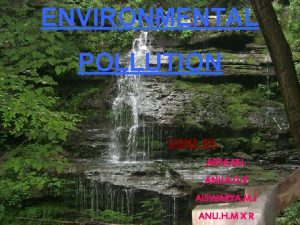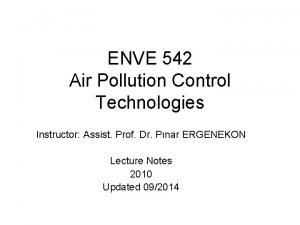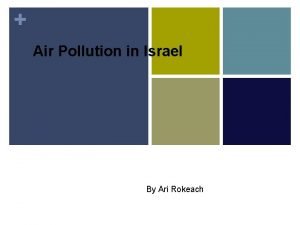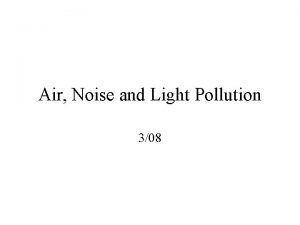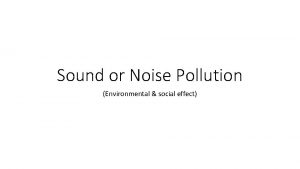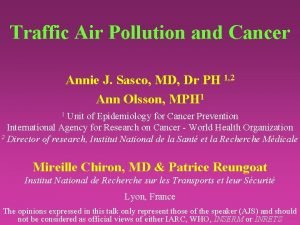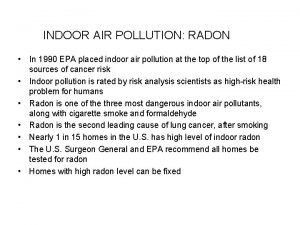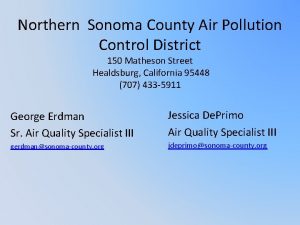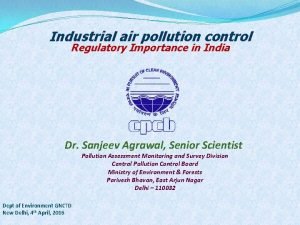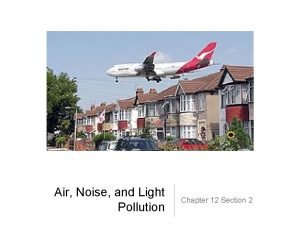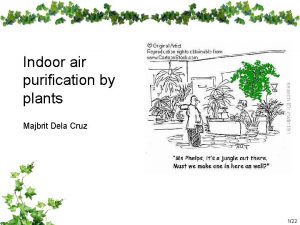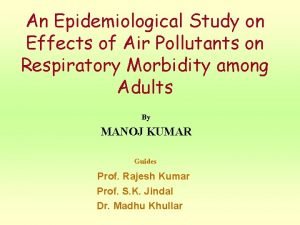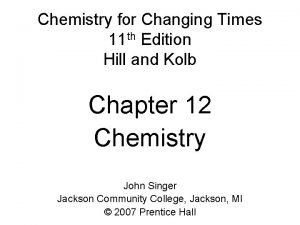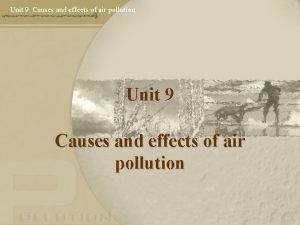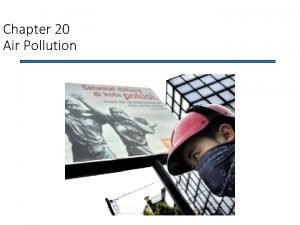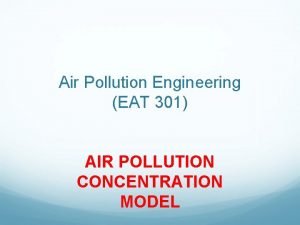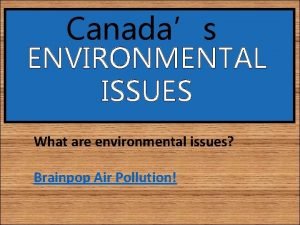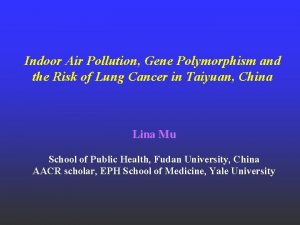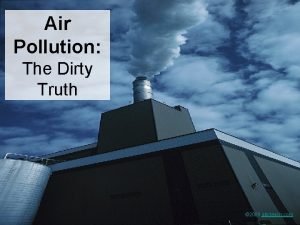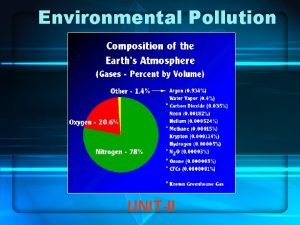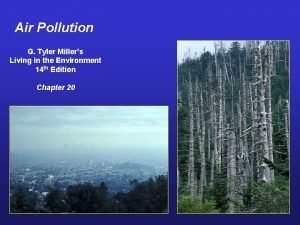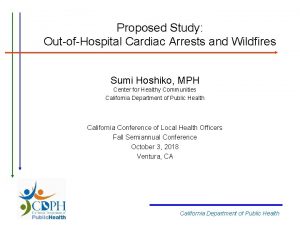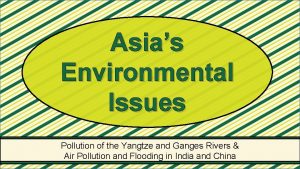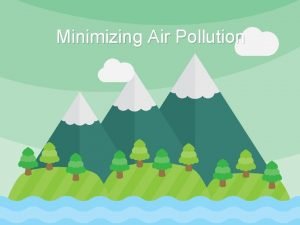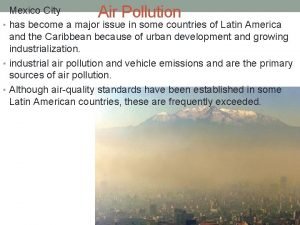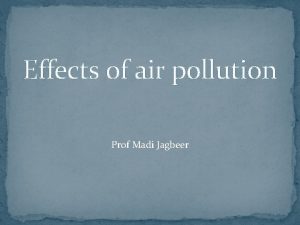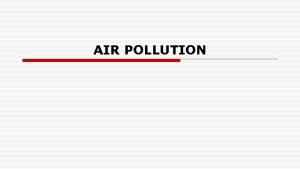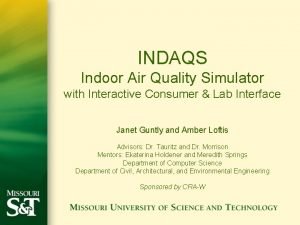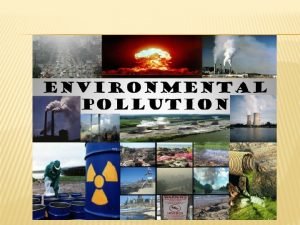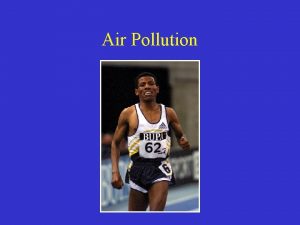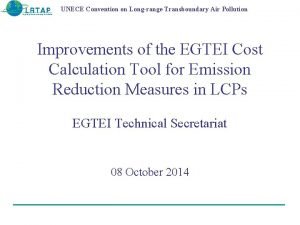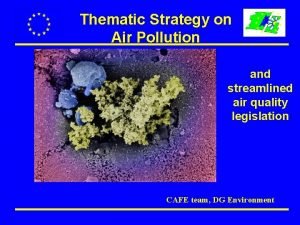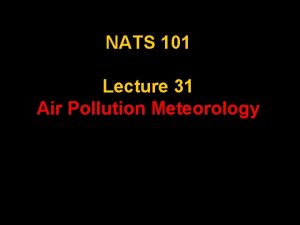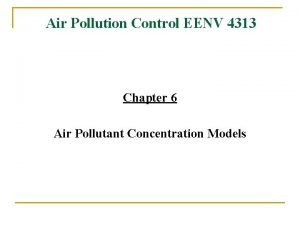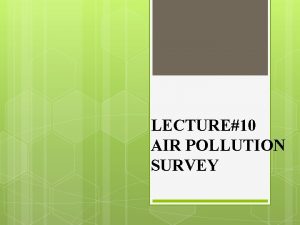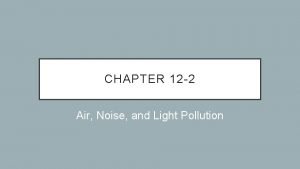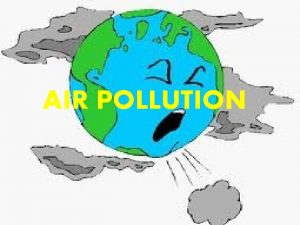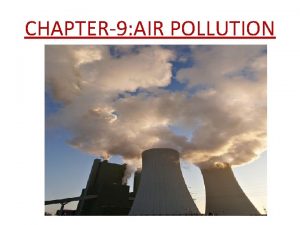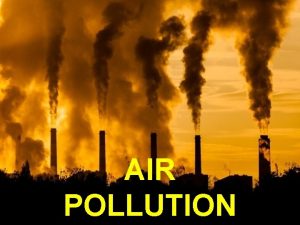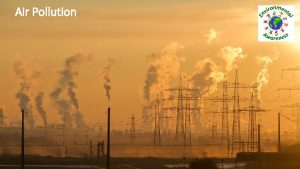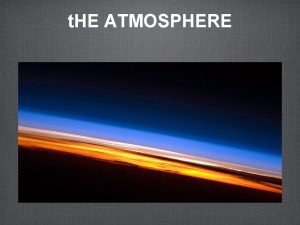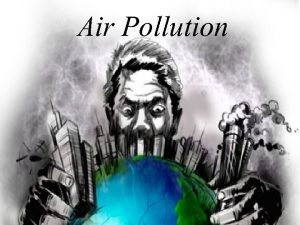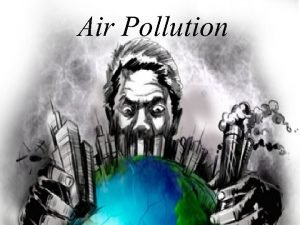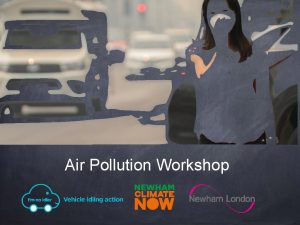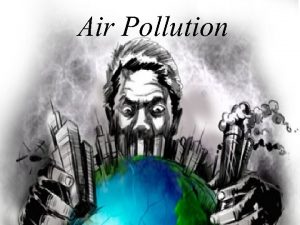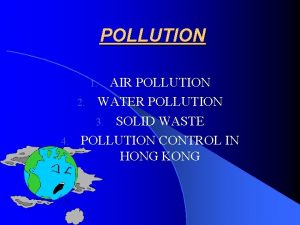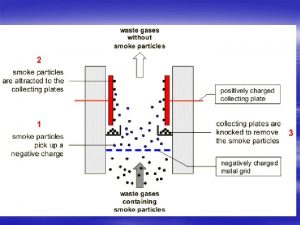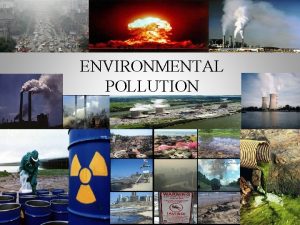Earths atmosphere Air pollution Earths atmosphere n n






















































- Slides: 54

Earth’s atmosphere. Air pollution.

Earth’s atmosphere n n n is a layer of gases surrounding the planet Earth and retained by the Earth's gravity. It contains roughly 78%nitrogen, 21%oxygen, 0. 97%argon, 0. 04%carbon dioxide, and trace amounts of other gases, in addition to water vapor.

An air pollutant can be a chemical n physical (particulate matter or dust) n biological agent that modifies the natural characteristics of the atmosphere. Worldwide air pollution is responsible for large numbers of deaths and cases of respiratory diseases. n

Health problems resulting from air pollution aggravated asthma n bronchitis n emphysema n lung and heart diseases n respiratory allergies n

Air quality standards n n n In the United States there was issued the Clean Air Act that has already reduced concentrations of some pollutants. The Clean Air Act sets numerical limits on the concentrations of basic group of air pollutants and provides reporting and enforcement mechanisms. The European Union follows the initiative.

Antropogenic (manmade) sources of air pollution Marine vessels n Burning fossil fuels n Burning wood, fireplaces, stoves, furnaces and incinerators n Combustion-fired power plants n Controlled burn practices in agriculture and forestry n Motor vehicles n

Other antropogenic sources n n n Chemicals, dust and crop waste burning in farming. Fumes from paint, varnish, aerosol sprays and other solvents. Waste deposition in landfills, which generate mathane. Military uses, as nuclear weapons, toxic gases, and rocketry. Oil refining, power plant operation and industry.

Natural sources n n n Methane, emitted by the digestion of food by animals, for example cattle. Pine trees, which emit volatile organic compounds (VOCs). Radon gas from radioactive decay within the Earth's crust. Smoke and carbon monoxide from wildfires. Volcanic activity, which produce sulfur, chlorine , and ash particulates. Dust from natural sources.

Indoor air pollution, or Indoor air quality (IAQ) Radon is a gas of carcinogenic properties trapped inside houses. n Formaldehyde is emitted by building materials. n Volatile Organic Compounds (VOCs) are given off by paints and solvents. n Lead paint can degenerate into lead containing dust and be inhaled. n

Indoor air pollution Air fresheners, incense and other scented items. n Smoke from wood fires in stoves and fireplaces. n Arsenic and manganese in shower water (damaging to inhale). n Arsenic can be trapped in shower nozzle filter. n Pesticides. n

Indoor air pollution Carbon monoxide from incomplete combustion. n Hydrogen sulfide, deadly sewer gas (to stop it special traps are built into all domestic plumbing). n Tetrachloroethylene from dry cleaned clothes. n Asbestos from building materials. n

Smog n n is a type of air pollution; the word "smog" was coined in the early 20 th century as a portmanteau of the words smoke and fog to refer to smoky fog. The word was then intended to refer to what was sometimes known as pea soup fog, a familiar and serious problem in London from the 19 th century to the mid 20 th century. This kind of smog is caused by the burning of large amounts of coal within a city; this smog contains soot particulates from smoke, sulfur dioxide and other components. Modern smog, as found for example in Los Angeles, is a type of air pollution derived from vehicular emission from internal combustion engines and industrial fumes that react in the atmosphere with sunlight to form secondary pollutants that also combine with the primary emissions to form photochemical smog.

Health effects of ground -level ozone and photochemical smog Inflammation of breathing passages, decreasing the lung’s working capacity, shortness of breath, pain, wheezing, and coughing. n Eye and nose drying and irritation. n It increases susceptibility to infectious diseases. n

Carbon monoxide (CO) is a colourless, odourless and tasteless gas. n is the product of incomplete combustion n burns in air with a blue flame. n is toxic as when inhaled, it takes the place of oxygen in haemoglobin. It binds haemoglobin 200 -400 times more strongly than oxygen producing carboxyhaemoglobin. n

From 1999 through 2004 there were 439 unintentional, non-fire related carbon monoxide poisoning deaths annually in the U. S. n In 2007, there were 2, 302 hospitalizations for confirmed cases of unintentional, non-fire related carbon monoxide poisoning in the U. S. n

n In 2009 there were 552 persons with unintentional, non-fire related carbon monoxide poisoning who received hyperbaric oxygen treatment in the U. S.

Acute poisoning with CO n The main manifestations of poisoning develop in the organ systems most dependent on oxygen use, the central nervous system and the heart. The initial symptoms of acute carbon monoxide poisoning include headache, nausea, malaise, and fatigue. These symptoms are often mistaken for a virus such as influenza or other illnesses such as food poisoning or gastroenteritis. Headache is the most common symptom of acute carbon monoxide poisoning; it is often described as dull, frontal, and continuous. Increasing exposure produces cardiac abnormalities including fast heart rate, low blood pressure, and cardiac arrhythmia.

Acute poisoning with CO n n Central nervous system symptoms include delirium, hallucinations, dizziness, unstead y gait, confusion, seizures, central nervous system depression, unconsciousness, respiratory arrest, and death. Less common symptoms of acute carbon monoxide poisoning include myocardial ischemia, atrial fibrillation, pneumonia, pulmonary edema, high blood sugar, lactic acidosis, muscle necrosis, acute kidney failure, skin lesions, and visual and auditory problems. One classic sign of carbon monoxide poisoning is more often seen in the dead rather than the living - people have been described as looking pink-cheeked and healthy.

Concentration Symptoms 35 ppm (0. 0035%) Headache and dizziness within six to eight hours of constant exposure 100 ppm (0. 01%) Slight headache in two to three hours 200 ppm (0. 02%) Slight headache within two to three hours; loss of judgment 400 ppm (0. 04%) Frontal headache within one to two hours 800 ppm (0. 08%) Dizziness, nausea, and convulsions within 45 min; insensible within 2 hours 1, 600 ppm (0. 16%) Headache, tachycardia, dizziness, and nausea within 20 min; death in less than 2 hours 3, 200 ppm (0. 32%) Headache, dizziness and nausea in five to ten minutes. Death within 30 minutes. 6, 400 ppm (0. 64%) Headache and dizziness in one to two minutes. Convulsions, respiratory arrest, and death in less than 20 minutes. 12, 800 ppm (1. 28%) Unconsciousness after 2– 3 breaths. Death in less than three minutes.

Chronic exposure to CO n Chronic exposure to relatively low levels of carbon monoxide may cause persistent headaches, lightheadedness, depression, confusion, memory loss, nausea and vomiting. It is unknown whether low-level chronic exposure may cause permanent neurological damage. Typically, upon removal from exposure to carbon monoxide, symptoms usually resolve themselves. Chronic exposure may worsen cardiovascular symptoms in some people. Chronic carbon monoxide exposure might increase the risk of developing atherosclerosis. Long-term exposures to carbon monoxide present the greatest risk to persons with coronary heart disease and in females who are pregnant

First aid in CO poisoning Remove the victim from the exposure. n Apply CPR if needed. n Provide 100% oxygen for breathing. n Hyperbaric oxygen increases carboxyhaemoglobin dissociation. n

Carbon dioxide (CO 2) exists in Earth's atmosphere as a trace gas at a concentration of 0. 039% by volume n Carbon dioxide is colorless. At low concentrations, the gas is odorless. At higher concentrations it has a sharp, acidic odor. n At standard temperature and pressure, the density of carbon dioxide is around 1. 98 kg/m 3, about 1. 5 times that of air. n Is a greenhouse gas. n In solid state it is called dry ice. n

plants absorb carbon dioxide, light, and water to produce carbohydrate energy for themselves and oxygen as a waste product. n In medicine up to 5% of CO 2 is added to pure oxygen for stimaulation of breathing after apnea and to stabilize the O 2/CO 2 balance in blood. n

CO 2 toxicity CO 2 is an asphyxiant gas and not classified as toxic or harmful. n Concentrations of 7% to 10% may cause suffocation, manifesting as dizziness, headache, visual and hearing dysfunction, and unconsciousness within a few minutes to an hour. n

n Acute carbon dioxide physiological effect is hypercapnia or asphyxiation sometimes known by the names given to it by miners: blackdamp. Blackdamp is primarily nitrogen and carbon dioxide and kills via suffocation (having displaced oxygen). Miners would try to alert themselves to dangerous levels of blackdamp and other gasses in a mine shaft by bringing a caged canary with them as they worked. The canary is more sensitive to environmental gasses than humans and as it became unconscious would stop singing and fall off its perch.


Sulfur (sulphur) dioxide (SO 2) n Sulfur dioxide is the chemical compound with the formula SO 2. It is a toxic gas with a pungent, irritating smell, that is released by volcanoes and in various industrial processes. Since coal and petroleum often contain sulfur compounds, their combustion generates sulfur dioxide unless the sulfur compounds are removed before burning the fuel. Further oxidation of SO 2, usually in the presence of a catalyst such as NO 2, forms H 2 SO 4, and thus acid rain. Sulfur dioxide emissions are also a precursor to particulates in the atmosphere. Both of these impacts are cause for concern over the environmental impact of these fuels.

n n n Inhaling sulfur dioxide is associated with increased respiratory symptoms and disease, difficulty in breathing, and premature death. In 2008, the American Conference of Governmental Industrial Hygienists reduced the short-term exposure limit from 5 ppm to 0. 25 ppm. Exposure to sulfur dioxide is associated with preterm birth. In the United States, the Center for Science in the Public Interest lists the two food preservatives, sulfur dioxide and sodium bisulfite, as being safe for human consumption except for certain individuals who may be sensitive to it, especially in large amounts

Acid rain n n or acid precipitation occurs when SO 2 and NOx are emitted into atmosphere, undergo chemical transformations and are absorbred by water droplets in clouds. Acid rain has p. H less than 5. 6. Acid rain accelerates weathering in carbonate rocks and accelerates building weathering. It also contributes to acidificaton of rivers, streams and damage to conifer forests.


Oxides of nitrogen (NOx) Nitric oxide (NO) n Nitrogen dioxide (NO 2) n Dinitrogen monoxide (N 2 O) n Dinitrogen trioxide (N 2 O 3) n Dinitrigen tetraoxide(N 2 O 4) n Dinitrogen pentaoxide (N 2 O 5) n

Nitrogen oxides n Nitrogen oxides are a mixture of gases that are composed of nitrogen and oxygen. Two of the most toxicologically significant nitrogen oxides are nitric oxide and nitrogen dioxide; both are nonflammable and colorless to brown at room temperature. Nitric oxide is a sharp sweet-smelling gas at room temperature, whereas nitrogen dioxide has a strong, harsh odor and is a liquid at room temperature, becoming a reddish-brown gas above 70°F. Nitrogen oxides are released to the air from the exhaust of motor vehicles, the burning of coal, oil, or natural gas, and during processes such as arc welding, electroplating, engraving, and dynamite blasting. They are also produced commercially by reacting nitric acid with metals or cellulose. Nitrogen oxides are used in the production of nitric acid, lacquers, dyes, and other chemicals. Nitrogen oxides are also used in rocket fuels, nitration of organic chemicals, and the manufacture of explosives.

Oxides of nitrogen (NOx) n n n are produced during combustion. The most important source of NO 2 is internal combustion engines. aggravate asthmatic conditions. react with the oxygen in the air to produce ozone. can form nitric acid; when dissolved in atmospheric moisture the result can be acid rain damaging trees and forest ecosysytems. NO 2 is toxic by inhalation, causes lung edema.

Ozone (O 3) Is a triatomic molecule, consisting of three oxygen atoms. n The highest levels of ozone in the atmosphere are in the stratosphere (ozon layer is between 10 to 50 km above the surface). There it filters out the short wavelengths (less than 320 nm) of ultraviolet light. n

n n n Ozone (O 3) Low level ozone or tropospheric ozone is regarded as a pollutant by the WHO. It is formed by the reaction of sunlight an air containing hydrocarbons and nitrogen oxides that to form ozone. Ozone present in the upper troposphere acts as a greenhouse gas absorbing some of the infrared energy emitted by earth. Ozone depletion occurs due to chlorofluorocarbons (CFCs or freons) and bromofluorocarbons (halons). At the earth’s surface ozone can harm lung function and irritate respiratory system.

Ozone (O 3) n n n Ozone is produced by laser printers photocopiers and arc welders. Ozone is used for bleaching substances and for killing bacteria, for water and food disinfection, to deodorize air and objects, for plactics processing, cleaning and bleaching of fabrics. In medicine to decontaminate operating rooms.

Particulates n n n Or particulate matter (PM) are tiny particles of solid (a smoke) or liquid (an aerosol) suspended in gas. They range in size from 10 nanometers to more than 100 micrometers in diameter. Some PM originate from volcanoes, dust storms and forest fires. Human activities, especially fossil fuels burning also produce PM.

Pneumoconioses n Are lung diseases caused of dust. They can be (caused by silica dust or non fibrogenic. by inhalaton fibrogenic asbestos) or

Effects of asbestos n Significant exposure to any type of asbestos will increase the risk of lung cancer, mesothelioma and nonmalignant lung and pleural disorders, including asbestosis, pleural plaques, pleural thickening, and pleural effusions.

n When asbestos fibers are inhaled, most fibers are expelled, but some can become lodged in the lungs and remain there throughout life. Fibers can accumulate and cause scarring and inflammation. Enough scarring and inflammation can affect breathing, leading to disease.

n n Inhaling longer, more durable asbestos fibers (such as tremolite and other amphiboles) contributes to the severity of asbestos-related disorders. Exposure to asbestos can increase the likelihood of lung cancer, mesothelioma, and non-malignant lung conditions such as asbestosis (restricted use of the lungs due to retained asbestos fibers) and changes in the pleura (lining of the chest cavity, outside the lung).

n n n Changes in pleura such as thickening, plaques, calcification, and fluid around the lungs (pleural effusion) may be early signs of asbestos exposure. These changes can affect breathing more than previously thought. Pleural effusion can be an early warning sign for mesothelioma (cancer of the lining of the lungs). Most cases of asbestosis or lung cancer in workers occurred 15 years or more after the person was first exposed to asbestos. Most cases of mesothelioma are diagnosed 30 years or more after the first exposure to asbestos.

Asbestosis n n Results from heavy exposure to asbestos Symptoms: shortness of breath, cough, respiratory failure. There is also an increased risk for lung cancer and mesothelioma. Pathogenesis: asbestos fibres cause intersitial fibrosis in lower lobes. There is no curative treatment. Oxygen therapy relieves shortness of breath.

n Asbestosis is a serious, progressive, long-term disease of the lungs. Asbestosis is not a cancer. Inhaling asbestos fibers that irritate and inflame lung tissues, causing the lung tissues to scar, causes asbestosis. The scarring makes it hard to breathe and difficult for oxygen and carbon dioxide pass through the lungs. Asbestosis generally progresses slowly. The latency period for the onset of asbestosis is typically 10 -20 years after the initial exposure. The disease can vary from asymptomatic (no symptoms) to disabling and potentially fatal.

Signs and Symptoms of asbestosis can include: n n n Shortness of breath is the primary symptom A persistent and productive cough (a cough that expels mucus) Chest tightness Chest pain Loss of appetite A dry, crackling sound in the lungs while inhaling.

Mesothelioma n Mesothelioma is a rare cancer, which may affect the lining of the chest cavity, outside the lung (pleura) or the abdominal contents (peritoneum). Most mesotheliomas are caused by exposure to asbestos.

Lung Cancer n Lung cancer is a malignant tumor that invades and obstructs the lung's air passages. Cigarette smoking greatly increases the likelihood of a person developing lung cancer as the result of asbestos exposure. The most common symptoms of lung cancer are cough, wheezing, unexplained weight loss, coughing up blood, and labored breathing. Other symptoms of lung cancer include shortness of breath, persistent chest pain, hoarseness, and anemia. People who develop these symptoms do not necessarily have lung cancer, but they should consult a physician for advice.

Asbestosis n Heavy asbestos fibres cause intersitial fibrosis in lower lobes.

Silicosis n n n Silica dust causes nodular lesions (nodular fibrosis) in upper lobes. Symptoms: tachypnea, shortness of breath, cough, fatigue, changes in breathing pattern (rapid breathing or shallow breathing), loss of appetite, chest pain, fever, cyanosis, cor pulmonale, respiratory insufficiency, patients are particularly susceptible to tuberculosis (silicotuberculosis). Silicosis is an irreversible condition. There is no cure.

Silicosis n Silica dust causes nodular lesions (nodular fibrosis) in upper lobes.

Black lung disease n Black lung disease is a pneumoconiosis caused by inhalation of carbon dust and silica dust by workers in coal miners.

Airborne diseases n refers to any diseases which are caused by pathogens and transmitted through the air. These viruses and bacteria can be spread through coughing, sneezing, laughing or through close personal contact. These pathogens ride on either dust particles or small respiratory droplets and can stay suspended in air and or are capable of traveling distances on air currents.

Airborne diseases n n n Tuberculosis Anthrax (inhalational), Chickenpox, Influenza, Measles, Smallpox.

n Airborne diseases are most commonly seen in unsanitary household conditions and overcrowded areas. Also, these diseases thrive in areas of poverty and poor hygienic conditions. Tuberculosis happens to be one of the most leading causes of death in adults from infectious diseases. Around 95% of people suffering from this disease are from developing areas in the world. Measles and diphtheria are two diseases found in poverty conditions, but over the years these diseases have been eliminated due to vaccines in developed countries.
 Earths early atmosphere contained
Earths early atmosphere contained Chapter 12 section 1 what causes air pollution answers
Chapter 12 section 1 what causes air pollution answers Chapter 12 air section 1 what causes air pollution
Chapter 12 air section 1 what causes air pollution Hubungan air dengan tanah
Hubungan air dengan tanah Objective about pollution
Objective about pollution Air pollution control technology
Air pollution control technology Ari rokeach
Ari rokeach Air pollution consequences
Air pollution consequences C o n c l u s i o n
C o n c l u s i o n Soil pollution images diagram
Soil pollution images diagram Conclusion of air pollution
Conclusion of air pollution Radon indoor air pollution
Radon indoor air pollution Northern sonoma county air pollution control district
Northern sonoma county air pollution control district Air pollution 2050
Air pollution 2050 Air pollutant definition
Air pollutant definition Section 2 air noise and light pollution
Section 2 air noise and light pollution Indoor air pollutants
Indoor air pollutants Aims and objectives of air pollution
Aims and objectives of air pollution Air pollution wildfires
Air pollution wildfires Air pollution
Air pollution Two sources of air pollution
Two sources of air pollution Example of environmental sustainability
Example of environmental sustainability Air pollution box model example
Air pollution box model example Erg air pollution control
Erg air pollution control Natural resources photos
Natural resources photos Introduction about air pollution
Introduction about air pollution Air pollution
Air pollution Indoor air pollution examples
Indoor air pollution examples Brainpop canada
Brainpop canada Air pollution
Air pollution Main cause of air pollution
Main cause of air pollution Baghouse filter diagram
Baghouse filter diagram 2 causes of soil pollution
2 causes of soil pollution Air pollution
Air pollution Air pollution specialist
Air pollution specialist Air pollution wildfires
Air pollution wildfires 5 effects of air pollution
5 effects of air pollution Air pollution
Air pollution Air pollution mexico
Air pollution mexico Define mobile sources of air pollution
Define mobile sources of air pollution Effects of air pollution in plants
Effects of air pollution in plants Prevention of indoor air pollution
Prevention of indoor air pollution Air pollution control methods
Air pollution control methods Air pollution simulator
Air pollution simulator What is inorganic pollution
What is inorganic pollution Secondary air pollutants
Secondary air pollutants General effects of air pollution
General effects of air pollution Baghouse filter definition apes
Baghouse filter definition apes Air pollution consequences
Air pollution consequences Conclusion of air pollution
Conclusion of air pollution Air pollution
Air pollution Air pollution
Air pollution Air pollution control engineering noel de nevers solution
Air pollution control engineering noel de nevers solution Objectives of air pollution
Objectives of air pollution Air noise and light pollution
Air noise and light pollution




